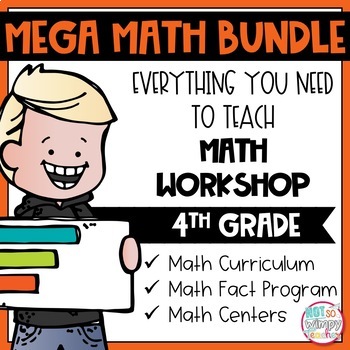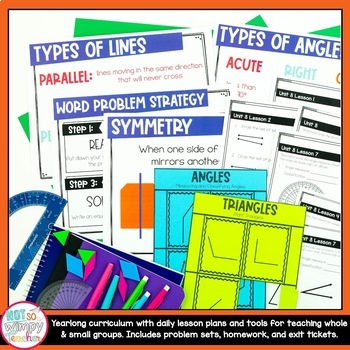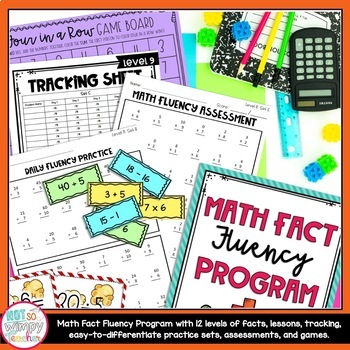Math Mega Bundle FOURTH GRADE
- Various file types
What educators are saying
Products in this Bundle (22)
showing 1-5 of 22 products
Description
This bundle includes EVERYTHING you need to teach math workshop in fourth grade including lesson plans, interactive mini-lessons, student printables, small-group activities, assessments, project-based learning activities, a complete fact fluency program with mixed-fact practice, and 90 done-for-you hands-on math centers.
We’ve combined three of our most popular products into one amazing mega bundle to save you time and money. This resource includes our fourth grade math curriculum, math fact fluency bundle (addition, subtraction, multiplication, and division), and fourth grade math centers. Individually, these products would cost over $300.00, but when you purchase them together you can get ALL THREE incredible resources for just $225.
And, even better, you can rest easy knowing that you have EVERYTHING you need to teach a fun, engaging, and effective math workshop every day. This bundle includes everything from anchor charts and reference tools to PowerPoint mini-lessons and small group activities, mixed-fact practice sheets, and problem sets to games and project-based learning activities. This is the math program you have been dreaming about.
We’ve literally created everything you need to teach all the fourth grade standards and put it all together into one AMAZING product for you. Whole group lessons, small group activities, independent practice, hands-on centers, homework, collaborative review, assessments - it’s ALL included!
What’s Included:
- 10 student-friendly units (see list below)
- The “At a Glance” calendar shows which lesson is being taught each day of the unit.
- Vocabulary cards help students learn new vocabulary.
- A pre-assessment lets you know what prior knowledge your students already have.
- Anchor charts provide helpful reminders for new skills and strategies.
- 1-page daily lesson plans and activities for small group instruction make lesson planning a breeze.
- Instructional PowerPoints ensure that daily mini-lessons are interactive and easy to prepare.
- Each lesson includes student problem sets and homework.
- Interactive notebook activities keep students engaged and provide great reference tools.
- Exit tickets for each lesson make share time easy and allow you to do a quick formative assessment.
- The units include helpful tools and resources: hundreds charts, skip counting charts, horizontal and vertical number lines, midpoint number lines, and more!
- Math games provide extra practice in a fun and engaging format that students love.
- 5 project-based learning activities for hands-on, authentic math practice.
- Our fan-favorite Math Test Prep Escape Room for a fun and engaging review that will have your students hitting it out of the park on test day.
- Task cards are included for use in centers or as a whole group activity.
- A comprehensive assessment with questions modeled after standardized tests allows students to practice important skills while you assess learning. We’ve also included a scoring rubric which makes it easy to see which skills students still need to master at a glance.
- An FAQs section provides answers to commonly asked questions about the resource and helps you get started right away.
Units Included:
Unit 2: Place Value, Addition & Subtraction
Unit 6: Operations with Fractions
Unit 7: Fractions and Decimals
Want to see the math curriculum in action? Try a FREE lesson HERE.
- 90 hands-on math centers
- Center activities include sorts, task cards, math writing, matching, and a recording book that students use for all 10 centers in each set
- 40-page “Math Center Teacher Tips and Tricks” documents with math center tips, schedules, and labels
Centers Included:
Back to School
Want to try a FREE Math Center? Click HERE.
What’s Included:
- Daily math facts practice pages: Each math fact skill has five different practice sets. Each practice set has 4 days of mixed-fact practice. 128 days total days
- Levels 9 and 12 - Advanced multiplication and division fact practice pages include 6 math fact sets. The first five focus on a single factor set of facts and the final set focuses on mixed advanced facts: Set A: x/➗11, Set B: x/➗12; Set C: x/➗ 20; Set D: x/➗ 50; Set E: x/➗100; Set F x/➗ mixed facts
- Math Facts Assessments: Each math fact skill has five different assessments (except levels 9 and 12, which have 6) (32 total assessments).
- Math Facts Games: Each operation has 5 different math games: the Pop, Swat a Fact, BINGO, Fidget Spinner, Four in a Row)
- Additional list of fluency games that are easy to implement in the classroom
- Flashcards: addition, subtraction, multiplication, and division flashcards for every fact in the program
- Answer keys
- Tracking sheets for students and teachers: Several different types of tracking sheets help you monitor student progress. Graphing trackers are also included for student use.
- Suggested times for practice and assessments
- Binder covers and spine labels to help with organization
- Detailed teacher directions with tips and suggestions for simple implementation
Math Facts Included:
There are a total of 12 levels of math facts included in this bundle.
There are six levels of math facts included in the addition and subtraction program:
- Level 1: Mixed fact addition within 10
- Level 2: Mixed fact addition within 20
- Level 3: Mixed fact subtraction within 10
- Level 4: Mixed fact subtraction within 20
- Level 5: Mixed addition and subtraction within 10
- Level 6: Mixed addition and subtraction within 20
There are six levels of math facts included in the multiplication and division program:
- Level 7: Basic Mixed Multiplication x0, x1, x2, x5, x10
- Level 8: Mixed Multiplication (0-10)
- Level 9: Advanced Multiplication x11, x12, x20, x50, x100
- Level 10: Basic Mixed Division ➗0, ➗1, ➗2, ➗5, ➗10
- Level 11: Mixed Division (0-10)
- Level 12: Advanced Division ➗11, ➗12, ➗20, ➗50, ➗100
❤️❤️ Why You Will LOVE This Resource ❤️❤️
- EVERYTHING you need to run an engaging and effective math workshop ALL YEAR!
- 1-page lesson plan so you don’t have to sift through 6-8 pages to plan your lessons
- Done-for-you PowerPoint that you can open and go -- letting it guide your whole-group lesson
- Detailed small group lesson plans that include intervention and enrichment suggestions (this is NOT usually in math curricula)
- Mixed-fact practice leads to true student mastery
- Hands-on learning activities, including games, task cards, and project-based learning
- Engaging centers review prior lessons to increase independence and decrease interruptions
How to Use It in the Classroom:
Everything you need to run an engaging and effective math workshop is included!
- Each mini-lesson will take about 20-30 minutes and you will need an additional 40-60 minutes for small group work and centers.
Warm-up activities:
- Use the Fact Fluency pages as a warm-up activity.
- Fact Fluency pages can be used in any order making it easy to differentiate.
Whole-group lessons:
- Use the PowerPoint mini lesson for your whole group instruction. Project on the whiteboard and have students participate in the interactive lesson.
- Complete class activities as a whole group, independently, or with partners.
- Use the interactive notebook as a whole-group activity.
- Project-based learning activities can be completed as a whole class review.
Small groups:
- Meeting with small groups of students each day is easy when you use the small group activities to guide your lessons.
- Use Interactive notebook activities in small groups to help struggling learners and easily assess mastery.
- Differentiation is easy with directions for intervention, on-level, and enrichment activities.
Centers:
- Keep students busy while you meet with small groups with tons of included materials
- Fact fluency games and flashcards make great center activities
- Engaging, hands-on centers provide ready-to-use materials for center rotations.
- Center activities are designed to review previously taught skills. This allows students to be more independent and successful.
- Use included games to review standards-based skills in a fun way.
- Let students complete project-based learning activities with a partner or small group or in a math center.
Sharing:
- Take a few minutes to share at the end of class. Students will enjoy getting to share what they learned and learning a little bit about their new classmates.
- Exit tickets make sharing time easy.
Assessment:
- Pre-assessments guide your lesson progression.
- Problem sets, homework, exit tickets, and interactive notebooks make formative assessment a breeze.
- Fact Fluency assessments can be completed in any order. Students can stay on each problem set as long as they need to.
- You can decide how many problems students need to complete for mastery.
- Use suggested times or eliminate the timed component.
- Comprehensive assessments use question formats modeled after standardized tests.
- Tracking sheets make it easy to monitor student progress.
Differentiation:
- Use included intervention, on-level, and enrichment activities to provide differentiated instruction.
- Fact fluency problem sets and assessments are designed for ultimate flexibility-you to determine. what problem sets students work on, for how long they stick with one problem set and the criteria for “fluency”.
- Small group instruction provides the opportunity to provide individualized instruction to ALL learners.
- Included resources and tools like hundreds charts, multiplication tables, and number lines make great reference tools for struggling learners.
- Allow learners to use completed interactive notebook activities for support.
- Anchor charts and vocabulary cards scaffold learning.
- Allow students to work with a partner or in small groups to complete more challenging assignments.
- Assign different numbers of practice problems or choose the level of difficulty based on student needs.
FAQs:
Q: What’s included in this bundle?
A: This bundle includes three of our most popular products for fourth grade: fourth grade math curriculum bundle, math fact fluency program, and fourth grade math centers.
Q: Is this a full-year curriculum?
A: Yes, this bundle contains a full year’s worth of standards-based math curriculum for fourth grade. There are 10 math units, 90 math centers, and a full year of math fact practice for all four operations. It is a complete math curriculum.
Q: Can I buy the products individually?
A: Yes. Each product is available individually. You can also buy individual units and/or centers, but you get maximum savings by purchasing the bundle.
Q: What grade is this for?
A: This unit was created specifically for grade 4 with fourth grade standards in mind.
Q: I am required to use a specific school curriculum. How can I use this curriculum?
A: Great question! Our curriculum is a great supplement to your existing curriculum. Many teachers have found that the lessons are more simple and straightforward and they help students understand difficult concepts. The small group lesson plans. Intervention and enrichment options, task cards, and project-based learning are a great addition to any curriculum. Our fact fluency features mixed-fact practice, which is a great alternative to most school fact programs and results in true learning.
Q: How long do the mini-lessons take?
A: The mini-lessons will take 20-30 minutes.
Q: When do I use the math centers?
A: You can use the math center materials for your independent center while you are meeting with small groups. The hands-on activities provide a great review for students and can be completed independently. Our math centers are designed to be used after you have taught a skill.
Q: How many copies of each center do you make?
A: I only make one copy of each center set. My students divide up into groups. So, while some are working with me, others are on a technology activity, others are doing these centers, and the last group is playing fact games. The group that is at independent centers, completing these activities, shares all 10 sets. If a child in their group is using center 1, then they take center 2 and work on that one.
Q: What manipulatives do I need to complete the math centers?
A: Not many! Red, blue, green, and orange crayons, dice, a paper clip, minute timer or stopwatch, and a ruler. The centers keep students actively learning without needing to set up a great deal of manipulatives. High engagement/low prep is a win!
Q: When do I use the Fact Fluency program?
A: The Fact Fluency program makes a great warm-up activity. You can also place the games or flashcards in your Fact Fluency center for students to practice while you are teaching the small group portion of the lesson.
Q: What level and set of the Fact Fluency program do I start with?
A: You can start on any level or set you like. I would suggest starting with a level that covers a skill your students have already learned. This program is not designed to teach students the facts, but to encourage practice and fluency of facts that have already been taught. All of the sets include the same math facts. You can use the sets in any order, or even mix them up.
Q: When do I move students to a new fact fluency level or set?
A: This is entirely up to you. You can have students working on the same set for a couple of weeks or switch it up every week.
Q: Some of my students are stuck on the same skill and still are not mastering the math facts at that level. What should I do?
A: Students do not need to master each set to move on to a different set or level. Keep in mind that mastery might look different for each student. We want to encourage fact practice and fluency but not to the point of frustration. Please move your students to additional levels and operations throughout the year so they can practice all the fluency levels covered within your grade level.
Q: How long should I give my students to complete math facts assessments?
A: Fluency can look different for each student, grade level, and school. You can start with 30 seconds for each practice box and a minute for each assessment. Feel free to adjust the time according to your class needs and goals. It is also ok to not time your students. Sometimes the timer stresses students more and can be a negative experience.
Q: When do I incorporate fluency practice into my math block?
A: You can use math fact fluency practice as a warm-up activity, the way that we do in our Fourth Grade Math Curriculum. Math centers are a great place to include fluency practice. In a math fact center, students can practice their daily practice page, play math fact games, and even use technology. On Friday you can give the students the assessment.
Q: Why do level 9 and level 12 of the math fact fluency program have 6 sets instead of 5?
A: The advanced multiplication and advanced division levels are more of an enrichment level. Sets A-E are not mixed facts. Set F is the mixed facts of the facts found in sets A-E.





